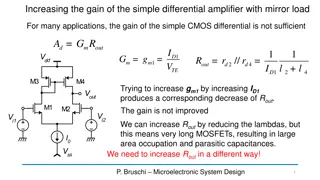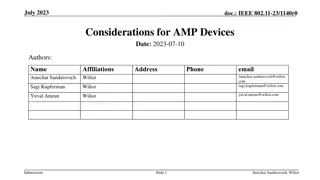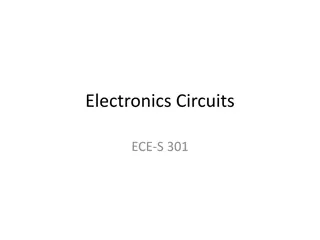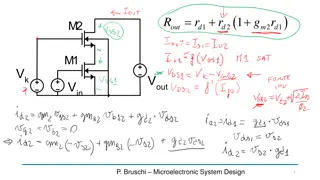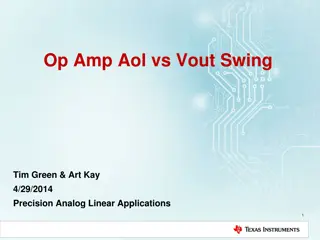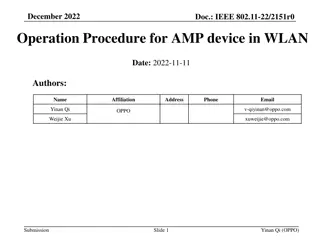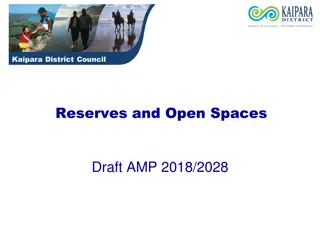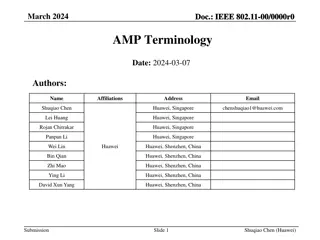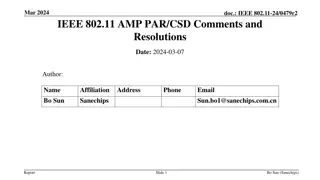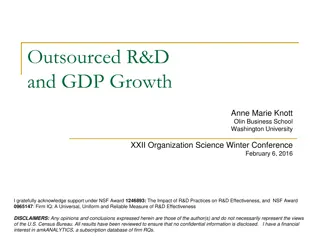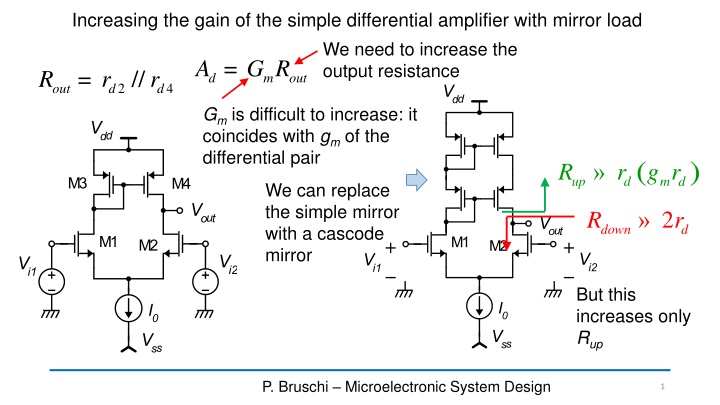
Cascode Differential Amplifiers for Increased Gain
Learn about improving the gain of simple differential amplifiers by using cascode mirror loads and adding common gate stages. Explore Cascode Differential Amplifiers, CMOS Cascode Amplifiers, and the input common mode range in microelectronic system design.
Download Presentation

Please find below an Image/Link to download the presentation.
The content on the website is provided AS IS for your information and personal use only. It may not be sold, licensed, or shared on other websites without obtaining consent from the author. If you encounter any issues during the download, it is possible that the publisher has removed the file from their server.
You are allowed to download the files provided on this website for personal or commercial use, subject to the condition that they are used lawfully. All files are the property of their respective owners.
The content on the website is provided AS IS for your information and personal use only. It may not be sold, licensed, or shared on other websites without obtaining consent from the author.
E N D
Presentation Transcript
Increasing the gain of the simple differential amplifier with mirror load We need to increase the output resistance 2 4 // d d r r = = A G R R d m out out Gmis difficult to increase: it coincides with gmof the differential pair ( ) R r g r up d m d We can replace the simple mirror with a cascode mirror 2 down R r d But this increases only Rup P. Bruschi Microelectronic System Design 1
Cascode differential amplifier ( ) @ 2 + 1 + 2 down R r r g r 2 4 4 2 d d m d 2rd2 We add a differential common gate stage (M3,M4) to the differential pair: forming a differential cascode stage P. Bruschi Microelectronic System Design 2
Cascode differential amplifier: Rout ( ) ( ) @ r r g @ + 1 + R r r r g 5 8 5 d d m 8 5 8 5 up d d d m ( ) ( ) @ 2d r r g 2 1 2 down R r r g r @ + + 4 2 4 d m 2 4 4 2 d d m d v R v R p p = + 2 i up p down R down R up down R = // R R out up 2 ( ) ( ) @ // R r r g r r g 5 8 5 4 2 4 out d d m d d m P. Bruschi Microelectronic System Design 3
Cascode differential amplifier @ - @ I I I g v 1 2 G v 1 OCC D D m d = I OCC m d I-to-I network = = G A g G R ) ( / / 1 m m d m out ( ) @ A g r g r r g r 1 2 4 4 8 5 5 d m d m d d m d If all devices have the same rdand gm: 2 ( ) g r Cascode Differential stage m d A @ d 2 V-to-I network P. Bruschi Microelectronic System Design 4
CMOS cascode amplifier: output range Upper limit out mirror V - V V MIN cascode V - V = - dd out |Vout-mirror| V MIN cascode V - - dd out ( ) max = - V V MIN cascode V - out dd As Voutgets higher than max(Vout), Rup decreases making the gain decrease P. Bruschi Microelectronic System Design 5
CMOS cascode amplifier: output range Lower limit V V V V V DSAT V = - 4 = 4 4 DS out - S V V V V 4 2 4 S k GS DSAT V V - + ) 2 4 4 out min k GS V ( = - + V DSAT V 2 4 4 out k GS ( ) min = - V V V In strong inversion: 2 4 out k t For an approximation of min(Vout) in weak inversion just add 100 mV P. Bruschi Microelectronic System Design 6
Input common mode range ( ) min iC V = V V = - + + V MIN tail V V V - 1 SS GS V 1 1 1 1 DS D S DSAT = = - V V V V V V 1 2 3 D k GS - 1 1 S iC GS V V V V DSAT V - - + 2 3 1 1 k GS iC GS VC VC ( ) iC V max = - + - V V V DSAT V 2 3 1 1 k GS GS ( ) iC V max @ - V DSAT V 2 1 k P. Bruschi Microelectronic System Design 7
Cascode amplifier: all ranges Vout Vdd Vdd max(Vout)=Vdd |VMIN-cascode| max(ViC)=Vk2 VDSAT1 Vout Vk2 Vic min(Vout)=Vk2 VGS4+VDSAT4 Vk2determines a trade- off between the input common mode range and the output swing min(ViC)=VSS +VMIN-tail+VGS1 Vss Vss P. Bruschi Microelectronic System Design 8
Adaptive Vk2 V V V V DSAT V - - + 2 3 1 1 k GS iC GS V V V V DSAT V - + + 2 1 3 1 k iC GS GS V + 1 V S = + V V DSAT V 2 1 3 1 k S GS = + V V V 2 1 10 k S GS = + V V DSAT V 10 3 1 GS GS P. Bruschi Microelectronic System Design 9
Adaptive Vk2 Same as in the case of a general cascode structure = + V V DSAT V 10 3 1 GS GS ) 10 ( ( ) - = + - V V mV V V 3 1 GS t DSAT GS t 3 = - I I I 0 - 0 eff B The adaptive Vk2does not solve the problem that, as ViCincreases, the output swing gets smaller. The advantage is that the amplifier is more flexible and no trade-off on VK2should be made in the design phase. T P. Bruschi Microelectronic System Design 10
Removing the interaction between input and output range: The Folded Cascode Folding According to the folding mechanism, the signal (variations) initially travels from one rail to the other and then invert direction and goes back to the initial rail out P. Bruschi Microelectronic System Design 11
Folded cascode amplifier: device currents Condition: = = - - I I I I I I 0 0 I I 6 1 2 D D 6 D 7 1 1 D D 7 D = - @ - I I I I I 7 9 7 6 OCC D D D ) ( - D ( ) = - - I I I I I 1 1 1 2 OCC D D ( ) = - - @- I I I g v 1 2 1 OCC D D m d P. Bruschi Microelectronic System Design 12
Folded cascode: setting the correct I1value Quiescent point: 0 0 I I I I I I = = - - 6 1 2 D D I I = = 0 I I I 0 1 2 D D 2 7 1 1 D D 2 I > 0 1 2 I I With a large input signal (|Vid|> VDMAX): V V V V < - 0 0 2 2 > : = I I 1 I 0 id DMAX D : = I 2 0 id DMAX D usually: I = I I I 1 0 1 0 P. Bruschi Microelectronic System Design 13
Folded cascode: differential mode gain G R OCC I @- = g v G g A = - 1 1 m = - d m m d m out A g R 1 d m out rd4 rd3 v i p = R Vk2 M7 out M6 p ip vp M8 M9 M1 M2 M10 M11 ros P. Bruschi Microelectronic System Design 14
Folded cascode: output resistance (2) (1) 1 p (2) 1 p ( p 1) (2) 2 p = + = + i i i i i i 1 2 2 p p rd4 rd3 = v v 1 p p = 0 v 1 p = 0 v 2 p = v v Vk2 M7 M6 2 p p ip1 vp1 ip2 M8 vp2 M1 M2 M9 = = v v v 1 = 2 p p p M10 M11 + i i i ros 1 2 p p p P. Bruschi Microelectronic System Design 15
Folded cascode: output resistance (2) v i R (1) 1 ( ) p @ 1 + = / /2 R r g R R r r (1) 1 p = 7 7 7 7 3 1 up d m S S d d ) 1 up ( @ / /2 R r g r r RS7 pi 7 7 3 up d m d d 2rd1 r + (1) 1 p (1) 1 p - = 3 d i i r (1) 1 2 r r pi (1) 1 p i 3 1 d d Rup - r (1) pi 2 r + (1) p (1) 1 p (1) 1 p = = 3 d i i i 2 - r 2 r r ros 3 1 d d P. Bruschi Microelectronic System Design 16
Folded cascode: output resistance (2) @ R r g r 9 9 11 dw d m d v R p (2) 2 p = i dw (2) 1 = 0 v R pi (2) 1 pi p Rdw (1) 1 p = i (2) 2 pi up r + (1) p (1) 1 p = 3 d i i 2 2 r r 3 1 d d ros v R v R r + p p = 1 + + 3 d i p 2 r r 3 1 up d d dw P. Bruschi Microelectronic System Design 17
Folded cascode: output resistance (3) - 1 1 1 r + = 1 + + 3 d i v p p 2 R r r R 1 1 = + R 3 1 up d d dw out R R up r + dw - 1 1 + 3 d 1 1 r + 2 r r = 1 + + 3 2 d R 3 1 d d out R r r R 3 2 up d d dw If rd2=rd3=rd7=rd9=rd11=rd gm7=gm9=gm = / / R R up r R ( r g r ) = R r g r 2 3 - out dw dw d m d ( 2 ( 3 dr ) ( ) / /2 r g r r d m d - = up r R 7 7 3 r + 1 d m d d - = up r R = R r g r 9 9 11 dw d m d 4 3 ) r g r 1 + 3 d d m d = R 2 r r out 3 1 d d P. Bruschi Microelectronic System Design 18
Folded cascode: differential mode gain = - A g R 1 d m out 2 ( ) ( ) r g r g r d m d m d = - = - A g d m If rd2=rd3=rd7=rd9=rd11=rd gm7=gm9= gm1= gm 3 3 2 ( ) Compare with the T g r m d A = d 2 ( ) g r w h h amplifier with mirror load (non-cascode) m d A = d 2 P. Bruschi Microelectronic System Design 19
Simple method to find if a terminal is inverting / non-inverting = - = A V g R - 1 d m out V V 1 2 D i i Signal paths: 1. From G to D: inversion 2. From G to S: no inversion 3. From S to D: no inversion P. Bruschi Microelectronic System Design 20
Ac, CMRR v r = @ c i i It is possible to demonstrate that, for VD=0, voltage and currents in the amplifiers are symmetrical. 1 2 d d 2 Then: os = v v out k 1 1 = = - + v v i 2 out k d g g 8 10 m m di di 1 2 v 1 1 v r = - di kv c = - + c v out 2 m os g r 2 g g vC vC 8 10 os m m for = = g g g 8 10 m m m 2 1 ( ) g r = - A m d CMRR m os g r ros C m os g r 3 P. Bruschi Microelectronic System Design 21
Folded cascode: output range ( ) min out SS V V = ( ) min out V V = + MIN cascode V - Lower limit + + V DSAT V 11 9 SS GS Upper limit V V V V DSAT V = + - 7 2 7 7 DS k GS out V V DSAT V V + - 2 7 7 k GS out ( ) max = + - V V V DSAT V 2 7 7 out k GS In strong inversion: Vout-mirror = - DSAT V V V 7 7 7 GS t ( ) max = + V V V 2 7 out k t P. Bruschi Microelectronic System Design 22
Maximum Vk2 ( ) max = + - V V V DSAT V 2 7 7 out k GS = = + V V V V 3 1 2 7 D D k GS |VDS3| Vk2sets the voltage of M1-M3 and M2-M4 drains = - = - - V V V V V V DSAT V 3 3 2 7 3 DS dd D dd k GS ( ) max = - - V V DSAT V V 2 3 7 k dd GS ( ) max = - - V V DSAT V DSAT V 3 7 out dd P. Bruschi Microelectronic System Design 23
Input common mode range ( ) iC V min = + + V MIN tail V V - 1 SS GS = = + V V V V 3 1 2 7 D D k GS M1 (M2) has the drain at a fixed voltage. If the gate voltage increases, M1 (M2) will eventually leave saturation = - = V = V V 1 1 1 DS V D V S ( ) + - - V V DSAT V 2 7 1 k GS C GS 1 ( ) C V max = + + - V V V DSAT V 2 7 1 1 k GS GS ( ) ( ) C V max = - - V V DSAT V V max = - + - V DSAT V V DSAT V 2 3 7 k dd GS 3 1 1 dd GS P. Bruschi Microelectronic System Design 24
The folded cascode as a single stage amplifier I-to-I network (KI=1) V-to-I network (Gm1=gm1) P. Bruschi Microelectronic System Design 25
Folded cascode: summary of properties DC Gain: Slightly smaller than the telescopic amplifier (non-folded cascode) gain. May reach several thousands or even 104(80 dB) with long mosfets. Larger than the gain of the cascade of two common source stages. ( ( ) ) Output swing: max = - - V V DSAT V DSAT V 3 7 out dd min = + + V V V DSAT V 11 9 out SS GS ( ) iC V ( ) C V min = + + V MIN tail V V Input CM range: - 1 SS GS max = - + - V DSAT V V DSAT V 3 1 1 dd GS P. Bruschi Microelectronic System Design 26
The only true advantage of the telescopic amplifier Current consumption (Isupply) = + @ 2 I I I I = @ I I I supply common-source supply current 0 CS CG common-gate supply current supply 0 CS CG CG Current re-use CS CS P. Bruschi Microelectronic System Design 27
Example of BJT Op-Amp with a Folded cascode input stage Wilson current mirror with emitter degeneration. Emitter-degenerated input pair (improves input differential range, with benefits in terms of Slew-Rate P. Bruschi Microelectronic System Design 28






